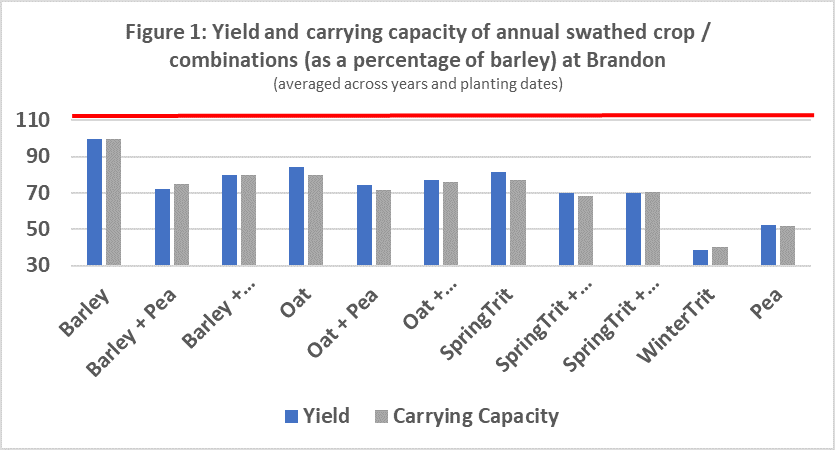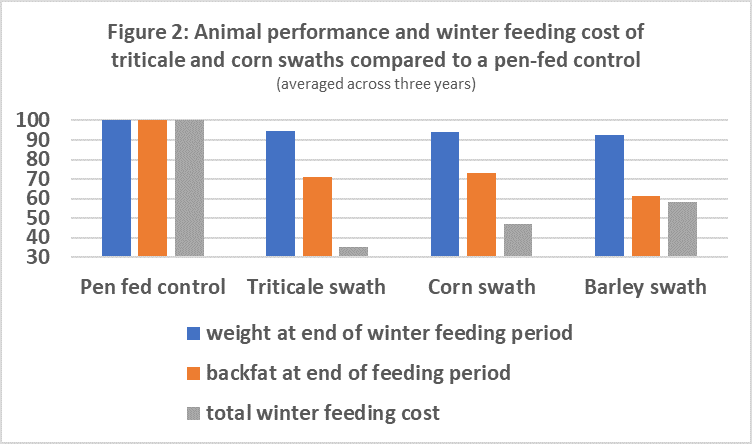Reducing Swath Grazing Costs, Part 2
| Project Code: | FRG.02.10 |
| Completed: | 2013 |
Project Title:
Reducing the Cost of Swath Grazing Cows by Increasing the Swathed-Crop Yield
Researchers:
Dr. Vern S. Baron baronv@agr.gc.ca
Dr. John A. Basarab, Dr. Don Salmon, Ms. Kristin Hacault, Mr. Albert Kuipers, Dr. Shannon Scott, Dr. Byron Irvine
Background: Swath grazing research indicates that swath grazing can reduce total daily feeding cost per cow by 41 to 48%. This is due more to the 78% reduction in yardage costs than the 25% reduction in feed costs. However, daily feed costs ranged from $0.61 to $1.80 per cow, largely due to the low and variable swath crop yields. To maximize forage yield, small grains must be harvested between late milk and hard dough stages. Barley is often planted in July so that it can be harvested at the soft dough stage in mid –September.
In the initial “Reducing Swath Grazing Costs” study, these researchers are studying corn and triticale for winter swath grazing compared to a drylot control. Corn and triticale use more of the growing season than barley, can be seeded sooner, have higher yields than barley, and maintain higher nutrient value than oats. Part 2 of the study is similar, but will include a traditional barley swath grazing control in the experimental design.
Objective: Compare daily feeding costs per cow, carrying capacity, utilization and cow performance in swath grazed corn, spring triticale and barley compared a dry lot control.
Swath-grazed triticale, corn and barley will be evaluated in a winter grazing trial comparing corn, triticale and a drylot control over three years. Cow weight change, body condition, carrying capacity, waste and nutritive value will be determined, winter weathering losses will be measured, and economic efficiency of the alternative crops and feeding systems will be evaluated.
What they did: Barley (Mann), oats (CDC Baler), spring triticale (Bunker), winter triticale (Bobcat) and field peas (Stella) were seeded in monocrop plots in Lacombe, Alberta and Brandon, Manitoba. Barley, spring triticale and oats were also sown in binary mixtures with winter triticale or field peas. Each crop or combination was sown on four different planting dates ranging from mid-May to late-June. Crops were swathed (barley and triticale at the soft dough stage, oats at the milk stage, and peas when the first pods ripened). Feed nutritional quality was evaluated. Potential carrying capacity and cost of production were calculated based on plot yields, forage quality and NRC nutrient requirements for beef cattle to identify the best swath grazing crop / combinations.
Two multi-year grazing trials were also conducted at Lacombe. The first trial evaluated swathed triticale and corn to a pen-fed control; the second compared swathed triticale, corn and barley with a pen-fed control. Paddocks in both trials were swathed and stocked with cattle according to dry matter yield, cow weight, and expected utilizations. Feed quality, and cow body condition measurements were recorded and economic analysis was completed.
What they found: weather (flooding, drought, and heat) played a role in how the various plots performed. Dry matter (DM) yield in Lacombe was almost 3 times higher than in Brandon across all years. On average mixtures and monocrops had similar yields, but there were significant differences between crops there were significant differences between barley, spring triticale and oat yields. Adding winter triticale or field pea did not significantly improve yields (figure 1) . As expected, winter triticale and field pea had the highest digestibility and crude protein and lowest fiber contents at Lacombe. In this trial spring triticale and oat had similar digestibility and ADF, but barley had significantly lower digestibility. Winter triticale and field pea did not improve digestibility in mixtures over oat and spring triticale grown alone. However, when field pea was grown in mixture with barley the mixture digestibility was higher than oat and spring triticale grown alone.

Barley was the lowest yielding crop in the grazing trial. Cattle grazing triticale tended to clean up pastures better than those grazing corn or barley with cattle grazing triticale eating over 80% of total swaths and cattle grazing oats and corn using under 80% on average. Corn provided more grazing days than other crops and barley provided the lowest. Generally, less land was needed to winter feed 100 cows for 100 days grazing triticale and corn than using barley swath grazing or a dry lot. Barley’s quality deteriorated the fastest after swathing followed by triticale and then corn and therefore cows lost more weight when swath grazing barley. Daily feed costs where lowest for triticale, corn and barley had similar costs, and the dry lot system had the highest daily feed costs (figure 2.).

What it means: Weather and climate plays a major role in the yield and quality of swath grazing crops – it is important to choose varieties that are known to do well in your area. There were both pros and cons to all crops used to swath graze. It is important to have a back-up plan when swath grazing. When just starting out with swath grazing, it helps to work with others in your area who know which crops perform best for the goals you are trying to achieve.








